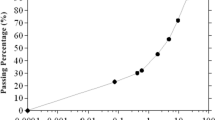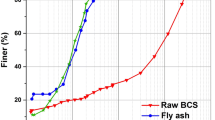Abstract
Contractors tout the use of organic acids for soil improvement even though the underlying stabilization mechanism is not well understood. Strength, stiffness, and chemical tests were conducted on two sandy materials treated with a commercial organic acid mixture to evaluate the effectiveness and stabilization mechanism involved. After curing for 28 days, tests show a moderate increase in unconfined compressive strength, approximately two-fold, and a large increase in constrained modulus, approximately one order of magnitude. X-ray diffraction and chemical analyses do not suggest traditional pozzolanic reactions as the source of improvements in the treated specimens. Test results suggest the organic acid solution promotes microbe growth and thus an increase in organic matter within the sand skeleton. This reduction in void space increases relative density to levels above the maximum unit weight of the host sand, resulting in higher soil strength and stiffness.
Similar content being viewed by others
References
Akbulut, S. and Saglamer, A. (2003) “Evaluation of fly ash and clay in soil grouting.” Proc. 3rd International Specialty Conf. on Grouting and Ground Treatment, GSP 120, ASCE, New Orleans, Louisiana, pp. 1192–1199.
Anagnostopoulos, C. A. and Papaliangas, T. T. (2012). “Experimental investigation of epoxy resin and sand mixes.” J. Geotech. Geoenviron. Eng., Vol. 138, No. 7, pp. 841–849.
ASTM (2001). Standard test methods for maximum index density and unit weight of soils using a vibratory table, D4253, West Conshohoken, PA, USA.
ASTM (2006). Standard test methods for minimum index density and unit weight of soils and calculation of relative density, D5254, West Conshohoken, PA, USA.
ASTM (2008). Standard guide for evaluating effectiveness of admixtures for soil stabilization, D4609, West Conshohoken, PA, USA.
ASTM (2010). Standard test methods for specific gravity of soil solids by water pycnometer, D854, West Conshohoken, PA, USA.
Baez, J. I. and Henry, J. F. (1993). “Reduction of liquefaction potential by compaction grouting at pinoplis dam, south carolina.” Proc. Geotechnical Practice in Dam Rehabilitation, GSP 35, ASCE, New York, pp. 430–466.
Baxter, C. and Mitchell, J. (2004). “Experimental study on the aging of sands.” J. Geotech. Geoenviron. Eng., ASCE, Vol. 130, No. 10, pp. 1051–1062.
Chatterjee, A. J. (2011). “Indian fly ashes: Their characteristics and potential for mechanochemical activation for enhanced usability.” J. Mater. Civ. Eng., ASCE, Vol. 23, No. 6, pp. 783–788.
Dejong, J. T., Fritzges, M. B., and Nüsslein, K. (2006). “Microbial induced cementation to control sand response to undrained shear.” J. Geotech. Geo environ. Eng., ASCE, Vol. 132, No. 11, pp. 1381–1392.
Dobson, T. (1987). “Case histories of the vibro systems to minimize the risk of liquefaction.” Proc. Soil Improvement: A Ten Year Update, GSP 12, ASCE, pp. 167–183.
Dombrowski, F. J., Ramme, B. W., Okwadha, G. D. O., and Kollakowsky, D. (2010). “Evaluation of surface water runoff from fly ash-stabilized and nonstabilized soil surfaces.” J. Env. Eng., ASCE, Vol. 136, No. 9, pp. 939–951.
Dove, J. E., Shillaber, C. M., Becker, T. S., Wallace, A. F., and Dove, P. M. (2010). “Biologically inspired silicification process for improving mechanical properties of sand.” J. Geotech. Geoenviron. Eng., ASCE, Vol. 137, No. 10, pp.949–957.
D’Appolonia, D. J., Whitman, R. V., and D’Appolonia, E. (1969). “Sand compaction with vibratory rollers.” J. Soil Mech. Found. Div., ASCE, Vol. 95, No. SM1, pp. 263–284.
El-Kelesh, A. M., Matsui, T., and Tokida, K. (2012). “Field investigation into effectiveness of compaction grouting.” J. Geotech. Geoenviron. Eng., ASCE, Vol. 138, No. 4, pp. 451–460.
Farouk, A., Lamboj, L., and Kos, J. (2004). “Influence of matric suction on the shear strength behavior of unsaturated sand.” Acta Polytechnica, Vol. 44, No. 4, pp. 11–17.
Harder, L. F., Jr., Hammond, W. D., and Ross, P. S. (1984). “Vibroflotation compaction at thermalito afterbay.” J. Geotech. Eng., ASCE, Vol. 110, No. 1, pp. 57–70.
Hobbie, J. E., Daley, R. J., and Jasper, S. (1977). “Use of nuclepore filters for counting bacteria by fluorescence microscopy.” Appl. Environ. Microbiol., Vol. 33, No. 5, 1225–1228.
Kazemian, S., Huat, B. B. K., Prasad, A., and Barghchi, M. (2010). “A review of stabilization of soft soils by injection of chemical grouting.” Aust. J. Basic Appl. Sci., Vol. 4, No. 12, pp. 5862–5868.
Kerwin, S. and Stone, J. (1997). “Liquefaction failure and remediation: king harbor redondo beach, california.” J. Geotech. Geoenviron. Eng., Vol. 123, No. 8, pp. 760–769.
Lin, D. F., Lin, K. L., Hung, M. J., and Luo, H. L. (2007). “Sludge ash/hydrated lime on the geotechnical properties of soft soil.” J. Hazard. Mater., Vol. 145, Nos. 1–2, pp. 58–64.
Liu, R., Durham, S. A., Rens, K. L., and Ramaswami, A. (2012). “Optimization of cementitious material content for sustainable concrete mixtures.” J. Mater. Civ. Eng., ASCE, Vol. 24, No. 6, pp. 745–753.
Lukas, R. G. (1986). Dynamic compaction for highway construction, vol. 1: design and construction guidelines, Report FHWA/RD-86/133, Federal Highway Administration, Washington DC.
Mayne, P. W., Jones, J. S., and Dumas, J. C. (1984). “Ground response to dynamic compaction.” J. Geotech. Eng., ASCE, Vol. 110, No. 6, pp. 757–774.
Miller, E. A. and Roycroft, G. A. (2004). “Compaction grouting test program for liquefaction control.” J. Geotech. Geoenviron. Eng., ASCE, Vol. 130, No. 4, pp. 355–361.
Mitchell, J. K. (1981). “State of the art — soil improvement.” Proc. 10 th ICSMFE, Stockholm, Vol. 4, pp. 509–565.
Mitchell, J. K. and Wentz, F. L. (1991). Performance of improved ground during the loma prieta earthquake, Report UCB/EERC-91/12, Earthquake Engineering Research Center, University of California, Berkeley.
Moayed, R. Z. and Naeini, S. A. (2012). “Improvement of loose sandy soil deposits using micropiles.” KSCE Journal of Civil Engineering, KSCE, Vol. 16, No. 3, pp. 334–340.
Mohanty, S. and Chugh, Y. (2006). “Postconstruction environmental monitoring of a fly ash-based road subbase.” Pract. Period. Struct. Des. Constr., ASCE, Vol. 11, No. 4, pp. 238–246.
Mooney M. A. and Rinehart R. V. (2009). “In situ soil response to vibratory loading and its relationship to roller-measured soil stiffness.” J. Geotech. Geoenviron. Eng., ASCE, Vol. 135, No. 8, pp. 1022–1031.
Muhunthan, B. and Sariosseiri, F. (2008). Interpretation of geotechnical properties of cement treated soils, Report WA-RD 715.1, Washington State Department of Transportation, p. 155.
Poulos, S. J. and Hed, A. (1973). “Density measurements in a hydraulic fill.” Evaluation of Relative Density and Its Role in Geotechnical Projects Involving Cohesionless Soils, STP 523, ASTM, pp. 402–424.
Rollins, K. M. and Kim, J. (2010). “Dynamic compaction of collapsible soils based on u.s. case histories.” J. Geotech. Geoenviron. Eng., ASCE, Vol. 136, No. 9, pp. 1178–1186.
Scholen, D. E. (1992). Nonstandard stabilizers, Report FHWA-FLP-92-011, Federal Highway Administration, Washington DC.
Shimada, K. (1998). “Effect of matric suction on shear characteristics of unsaturated fraser river sand.” J. Faculty Env. Sci. Tech., Okayama University, Vol. 3, No. 1, pp. 127–134.
Slocombe, B. C., Bell, A. L., and Baez, J. I. (2000). “The densification of granular soils using vibro methods.” Geotechnique, Vol. 50, No. 6, pp. 715–725.
Sylvia, D. M., Fuhrmann, J. J., Hartel, P. G., and Zuberer, D. A. (2005). Principles and applications of soil microbiology, Pearson Prentice-Hall, Upper Saddle River, N.J.
Townsend, F. C. (1973). “Comparisons of vibrated density and standard compaction tests on sand with varying amounts of fines.” Evaluation of Relative Density and Its Role in Geotechnical Projects Involving Cohesionless Soils, STP 523, ASTM, pp. 348–363.
Van Paassen, L. A., Ghose, R., van der Linden, T. J. M., van der Star, W. R. L., and van Loosdrecht, M. C. M. (2010). “Quantifying biomediated groundiImprovement by ureolysis: Large-scale biogrout experiment.” J. Geotech. Geoenviron. Eng., ASCE, Vol. 136, No. 12, pp. 1721–1728.
Author information
Authors and Affiliations
Corresponding author
Rights and permissions
About this article
Cite this article
Yee, E., Lee, J., Kim, Y. et al. Stabilization mechanism for sands treated with organic acids. KSCE J Civ Eng 18, 1001–1008 (2014). https://doi.org/10.1007/s12205-014-0498-y
Received:
Revised:
Accepted:
Published:
Issue Date:
DOI: https://doi.org/10.1007/s12205-014-0498-y




